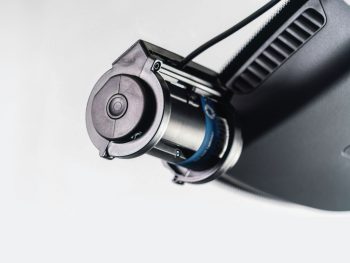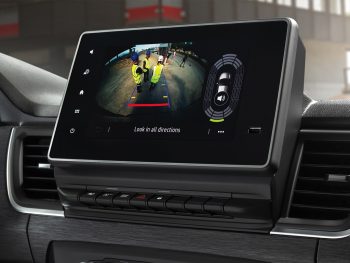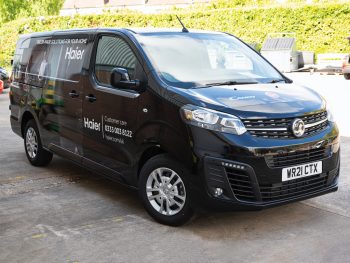What are the best protection products and strategies for your vehicle and its contents? Matt MacConnell investigates.

LCV owners may think their expensive tools and equipment are safe behind locked van doors and panelling. This scenario, however, can be more of an incentive for organised crime groups and other thieves; it’s a bit like covering your house in CCTV cameras and then pointing them out via signage — it shows that your property may have something to hide.
There’s a plethora of options on the market that can help keep your van and its contents safe from prying eyes. These products include deadlocks, cages and camera systems. LCV opera tors can also keep their vans safe by parking in a well-lit area and under a CCTV camera – this option might not apply to everyone, however.
Van protection expands beyond keeping contents safe. Accidents can be difficult to prove fault, which is something that can be vital when it comes to insurance investigations. As a result, dashcam sales and installations have soared in recent years, with many insurance companies now requesting footage in the event of an accident. Some insurance companies will also provide discounts if a dashcam is fitted to a vehicle.
LARGE VAN ISSUES

It can be difficult for LCV operators to gauge their surroundings when it comes to panel LCVs, especially in larger vans. No interior mirror means that vans that aren’t fitted with a reversing camera can be subject to a large blind spot at the rear. Nowadays, however, most new LCVs do come fitted with safety tech ranging from proximity sensors to 360-degree cameras.
Vans such as the new Nissan Townstar include a 360-degree camera – a standard feature on the Tekna+ trim. The Nissan Interstar will also feature a permanent rear-view camera, which is positioned as an interior mirror and will be available as an option on all trims from 2025. Nissan states that sonar technologies provide further assistance. For example, on its new Interstar, ‘flank protection’ encompasses six sensors on the front and rear, which provides an audio obstacle alert to the LCV operator.
Stellantis Pro One brands such as Citroën, Fiat and Vauxhall offer a Dynamic Surround Vision system. This technology allows for panel van operators to have a wide view around the vehicle, which helps navigate traffic and crowded areas. The Citroën Berlingo comes equipped with two cameras: one above the rear doors and one under the passenger exterior rear-view mirror. This image is then projected onto a wide digital central rear-view mirror, almost like you’re driving a panel-less van. The Berlingo also comes with 12 obstacle sensors at the front and rear.
SOLERA SOLUTIONS
“While rear cameras have become more prevalent, taking a piecemeal approach cannot fully address the visibility and safety challenges van fleets face. A holistic solution combining multi-angle HD cameras with vision-based AI is required,” says Grant Gardner, senior vice president, business operations and global supply chain at Solera, an automotive technology supplier. “We offer flexible aftermarket solutions that can be installed on virtually any existing van. By integrating live video streams from all sides of the vehicle, these intelligent camera systems provide a seamless 360-degree view, eliminating blind spots.”
Another positive of Solera cameras is that they double as a security system. The cameras can detect potential security threats such as vehicle break-ins and cargo theft, and footage is then uploaded automatically for viewing.
CLEVERER CAMERA
Camera systems are becoming increasingly powerful and intelligent. Most cameras no longer use SD cards, but content is instead uploaded directly to cloud storage, and this can usually be accessed via a portal. Most portals allow for multiple users, which means that the busy fleet manager can delegate fleet monitoring tasks to administration staff if required. Many systems will also automatically notify the fleet office when a vehicle has been involved in an accident, the content can then be quickly accessed and assessed.
“We are now seeing huge potential for dashcams as the hardware becomes increasingly more powerful and intelligent. The latest devices have advanced processing capacity and connectivity, ensuring they possess next-generation functionality that supports highly flexible and cost-efficient video telematics,” reveals Vernon Bonser, sales director at Queclink Wireless Solutions. “This capability helps to improve visibility around the vehicle and ultimately achieve higher levels of road safety, fleet risk, security and insurance improvements.
“By connecting with the CAN bus, a dashcam can now deliver all-in-one fleet and video telematics, providing critical insight on vehicle status to gain a greater understanding of performance and usage, bolstering robust location and behavioural data,” adds Bonser. “The ability to integrate with a vehicle’s communication system offers true telematics functionality, without the need for multiple technology solutions.”
Queclink also claims that sensor monitoring can provide further understanding of peripheral equipment and vehicle functions. For example, integrating a door sensor could feed an open or closed status to the system, which would then trigger recording – handy in the event of unauthorised loading/unloading.
Meanwhile, Sam Footer, partnership director for SureCam explains that the company’s dashcams form part of a video-enabled ecosystem for the best possible fleet management setup. “By taking advantage of integrated fleet products and systems it is possible to create a security system that better protects drivers, vehicles and loads,” he says. “The Geotab IoT platform means we can bring together fleet and video telematics for advanced visibility and monitoring, while integration with Peoplesafe’s lone worker safety system protects the driver both in and outside the vehicle.”
SureCam claims that they are seeing a demand increase for modular dashcams. The devices provided can be expanded from a forward-facing solution to include a driver-facing camera and a rear or side camera.
CASE STUDY > HAIER EUROPE

Haier Europe has implemented SureCam’s video telematics system across 250 vehicles in its fleet. Following the ongoing success of the video telematics, Haier’s insurance partner paid a 5% net premium bursary, which has been invested in 250 online risk assessments and 25 one-to-one driver training sessions to support road safety.
Haier claims that the system has been incredibly useful in challenging third-party not-at-fault claims. SureCam’s platform was integrated with TMC’s software to provide precise mileage and journey data, which helps audit employees’ business mileage and fuel expenditure.
“It has enabled us to take control of multiple aspects of our fleet, freeing up management time, saving operating costs and ultimately improving the safety of our drivers,” confirms Neil Parsons, Haier Europe fleet and facilities operations manager.
Haier Europe also uses an integrated monitoring service from Sopp+Sopp, which allows footage to be uploaded and graded. In analysis, 0.7% of triggered videos made up of collisions, near misses or events of interest were quickly identified. A further 43.9% provided useful driver behaviour insight, while the remainder were filtered out as false positives.
There’s more than meets the eye with clever camera systems. Most are equipped with sensors that help detect driver fatigue and careless driving. For example, if a driver is using their mobile phone or continues to be distracted while driving, a driver-facing camera can report this back to the office portal.
Dashcams can be a sensitive subject as many fleet operators may feel like they’re being spied on. To help with this obstacle, many companies include dashcams in revised contracts whereas others will combine it with an incentive scheme. For the latter, fleet management can incorporate incentives based on driver performance and safety. For example, all drivers could receive a driver score, and if an operator behaves by adhering to speed limits and not driving recklessly, an incentive could be given on top of their monthly salary or whatever the employer prefers.

